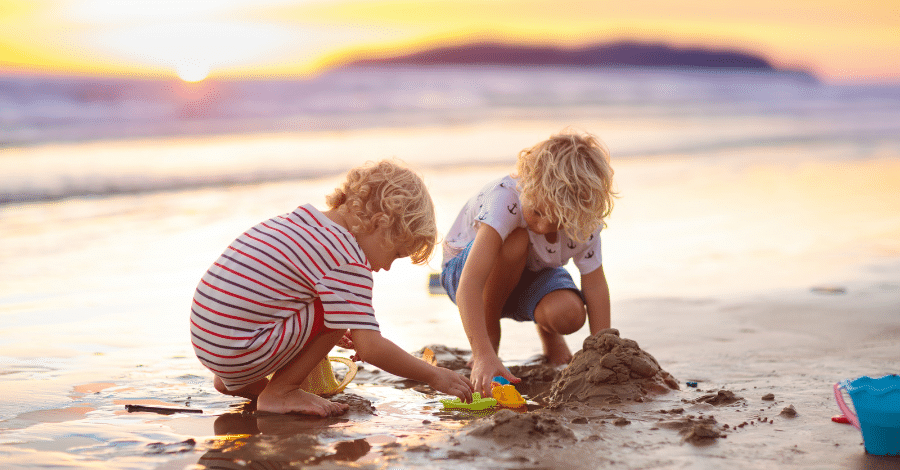When moving to Spain with your family you have to consider a host of things in addition to what you would normally think of with a regular move abroad. Schools, transportation to school, safety, entertainment options for kids and good healthcare are among the top concerns for parents.
International schools provide education tailored to global perspectives, while safety ensures peace of mind for parents. Walkability and efficient public transportation make daily life convenient, and a wealth of entertainment options keeps children engaged and learning.

Luckily, Spain offers all these features and then some, with cities like Madrid boasting world-class museums, Barcelona’s stunning beaches, and Alicante’s family-friendly promenades. From the cultural richness of Murcia to the sun-soaked shores of Marbella, Spain is sure to enrich your family life in ways you’re not even anticipating yet.
Here are our top choices for places to live in Spain for families:
1. Madrid
Family life in Madrid
As expected, Madrid tops the list, offering a vibrant urban lifestyle with a strong sense of community. The capital city is known for its friendly locals who embrace family values, creating a welcoming atmosphere for international residents. Children are cherished in Spanish culture, and Madrid reflects this with its numerous family-oriented spaces and activities. The city boasts a relatively low crime rate, making it generally safe for families.
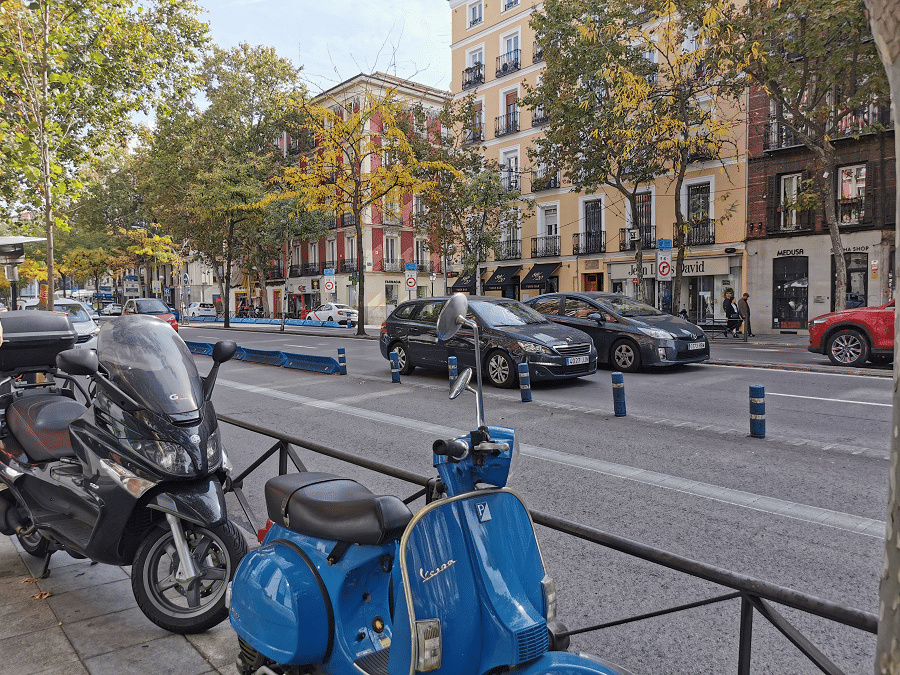
While some central areas can be noisy, many residential neighborhoods offer tranquil environments. Madrid’s excellent public transportation system and pedestrian-friendly streets contribute to its high walkability. English-speaking communities are prevalent, particularly in areas popular among expats, easing the transition for international families.
Safety in Madrid
Madrid is considered one of the safest large cities in Europe, with a strong police presence and well-lit streets. Violent crime is rare, though petty theft and pickpocketing can occur in tourist-heavy areas. Families often prefer residential areas like Chamartín, Retiro, and Moncloa-Aravaca for their low crime rates and family-friendly amenities.
Central areas like Sol and Gran Vía, while exciting, can be more prone to tourist-targeted crimes, especially at night. It’s advisable to exercise normal precautions, such as being aware of one’s surroundings and safeguarding personal belongings.
Schools in Madrid
Madrid offers a range of international schools catering to various curricula and languages. The American School of Madrid, located in Aravaca, follows an American curriculum and is known for its excellent facilities and diverse student body.
The International College Spain in La Moraleja offers the International Baccalaureate program and boasts a strong academic reputation. For those seeking a British education, King’s College School in Soto de Viñuelas provides a UK curriculum from early years through A-levels.
In the public sector, CEIP Ramón María del Valle-Inclán in Moratalaz is highly regarded for its bilingual Spanish-English program and innovative teaching methods.
IES San Isidro, one of the oldest secondary schools in Madrid, offers a rich historical environment alongside modern educational approaches. CEIP Joaquín Turina in Carabanchel is known for its inclusive approach and strong community involvement.
Play and entertainment in Madrid
Madrid abounds with family-friendly attractions. The CosmoCaixa science museum in Alcobendas offers interactive exhibits that make learning fun for all ages. The Planetario de Madrid in Tierno Galván Park provides an immersive space exploration experience.
For animal lovers, the Madrid Zoo Aquarium in Casa de Campo is home to thousands of species and includes a dolphin show.
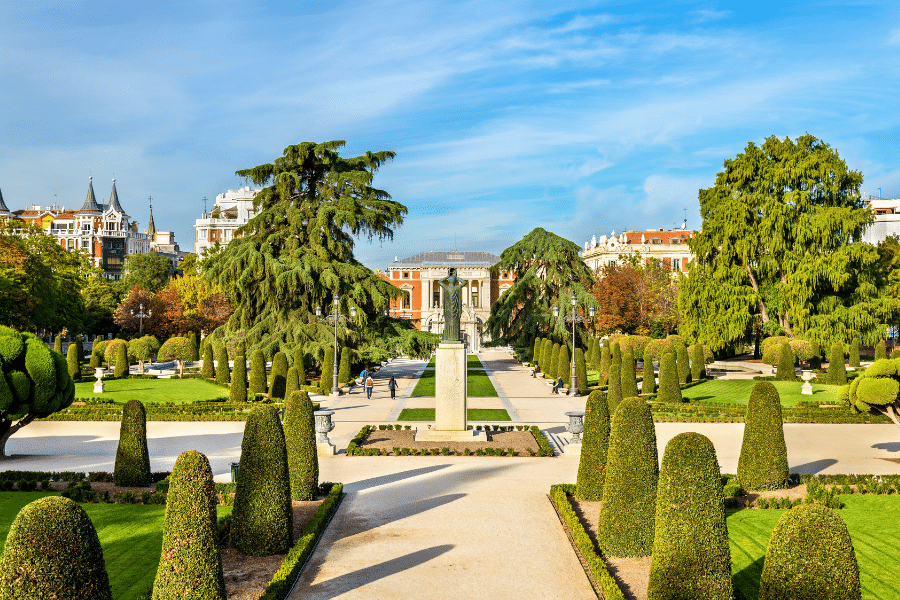
Outdoor enthusiasts will appreciate El Retiro Park, a vast green space in the heart of the city with a lake for rowing, playgrounds, and street performers. The Warner Bros. Park, located about 40 minutes south of Madrid, offers thrilling rides and entertainment for all ages. For water-based fun, Aquopolis water park in Villanueva de la Cañada provides a refreshing escape during hot summer months.
Family-friendly housing in Madrid
Madrid’s rental market offers diverse options for families across its many neighborhoods. According to My Dolce Casa’s Spain Rent Report 2024, the average rent in Madrid for a typical two-bedroom apartment, families can expect to pay around €1,500 per month. This is pricier than many other Spanish cities but reflects Madrid’s status as the capital and economic hub.
For those looking to buy, My Dolce Casa’s Spain Real Estate Market Report indicates that Madrid’s average property price is approximately €4,500 per square meter. A two-bedroom apartment might cost around €340,000, while a house could be priced at about €900,000. In terms of home price per square foot in Madrid, expect to pay about $460 per square foot, translating to roughly $370,000for a two-bedroom apartment or $920,000 for a house.
Family-friendly neighborhoods in Madrid include Chamartín, known for its excellent schools and green spaces, Retiro, which offers proximity to the famous park and good transportation links, and Moncloa-Aravaca, popular for its quieter suburban feel while still being close to the city center.
These areas typically feature a mix of modern apartments and traditional Spanish architecture, with many buildings incorporating family-friendly amenities like playgrounds and community pools.
Transportation and Walkability in Madrid
Madrid boasts an extensive and efficient public transportation system. The Metro, with its 12 lines, connects all major areas of the city and is complemented by a comprehensive bus network. The Madrid Transport app (EMT Madrid) is invaluable for navigating the city, providing real-time updates and route planning.
Typical routes like Line 1 of the Metro connect the historic center with modern business districts, while bus routes like the Circular line offer a scenic tour of the city’s main attractions. For regional travel, the Cercanías commuter rail system links Madrid with surrounding towns and cities.
Madrid-Barajas Airport, one of Europe’s busiest, offers excellent connections to international destinations. High-speed AVE trains connect Madrid with major Spanish cities like Barcelona (2.5 hours), Seville (2.5 hours), and Valencia (1.5 hours).
The city center is highly walkable, with many attractions within a 30-minute walk of each other. Bike lanes are increasingly common, and the BiciMAD public bike-sharing system provides an eco-friendly alternative for short trips.
Healthcare in Madrid
Madrid is home to some of Spain’s best healthcare facilities. Hospital La Paz, located in the north of the city, is renowned for its pediatric care and houses a dedicated children’s hospital. The Hospital Universitario 12 de Octubre in the south is a large public hospital known for its excellent maternity ward and neonatal care.
For private healthcare, the Hospital Quirónsalud Madrid in Pozuelo de Alarcón offers a wide range of specialties and is popular among expats for its English-speaking staff. The Hospital Sanitas La Zarzuela in Aravaca is another top-rated private facility, particularly noted for its obstetrics and gynecology departments.
2. Barcelona
Family life in Barcelona
Barcelona offers a unique blend of urban excitement and Mediterranean relaxation. The city’s coastal location provides a laid-back atmosphere, while its cosmopolitan vibe attracts families from around the world. Barcelonians are known for their open and friendly nature, and children are warmly welcomed in most settings.
The city’s compact layout and excellent public transportation make it highly walkable, with many neighborhoods offering a village-like feel within the larger urban context. English is widely spoken, especially in areas popular with expatriates, facilitating easy integration for international families.

Safety in Barcelona
While Barcelona is generally safe, it’s known for having a higher rate of petty theft compared to other Spanish cities, particularly in tourist-heavy areas. Violent crime is rare, but pickpocketing and bag-snatching can be issues in crowded places like Las Ramblas or busy metro stations.
Families often prefer residential areas such as Sarrià-Sant Gervasi, Pedralbes, or Gràcia for their lower crime rates and family-oriented amenities. The Gothic Quarter and El Raval, while historically and culturally rich, require more vigilance, especially at night. The city has increased police presence in recent years, particularly in popular tourist areas, to address safety concerns.
Schools in Barcelona
Barcelona offers a variety of international schools catering to different curricula and languages. The American School of Barcelona, located in Esplugues de Llobregat, offers an American curriculum and International Baccalaureate program.
The Benjamin Franklin International School in the Sarrià district provides an American education with a global perspective. For those seeking a British curriculum, the British School of Barcelona in Castelldefels offers education from early years through A-levels.
In the public sector, Institut Escola Costa i Llobera in Sarrià-Sant Gervasi is known for its innovative teaching methods and green surroundings. Escola Pau Casals in Gràcia offers a bilingual Catalan-English program and is praised for its inclusive approach. Institut Milà i Fontanals in the Raval neighborhood is recognized for its diverse student body and strong academic program.
Play and entertainment in Barcelona
Barcelona is rich in family-friendly attractions. The CosmoCaixa science museum in the Sarrià-Sant Gervasi district offers interactive exhibits that make science accessible and fun for all ages. The Barcelona Aquarium in Port Vell is one of Europe’s largest, featuring a stunning underwater tunnel.
For history enthusiasts, the Museu d’Història de Barcelona in the Gothic Quarter brings the city’s past to life through interactive displays.
Outdoor recreation options abound, with Parc de la Ciutadella offering a zoo, lake, and numerous playgrounds. Tibidabo Amusement Park, perched atop Tibidabo mountain, combines thrilling rides with panoramic city views. For water-based fun, Illa Fantasia water park in Vilassar de Dalt, about 30 minutes north of Barcelona, provides a perfect summer escape with its numerous slides and pools.
Family-friendly housing in Barcelona
According to My Dolce Casa’s Spain Rent Report 2024, the average rent in Barcelona is higher than the national average of €1,000. For a typical two-bedroom apartment, families can expect to pay around €1,600 per month. This reflects Barcelona’s status as a major European city and popular tourist destination.
For those looking to buy, Barcelona’s average home price at approximately €4,400 per square meter. This translates to about €330,000 for a two-bedroom apartment or €880,000 for a house. In terms of price per square foot, expect to pay about €381 per square foot, which equates to roughly €304,800 for a two-bedroom apartment or €762,000 for a house.
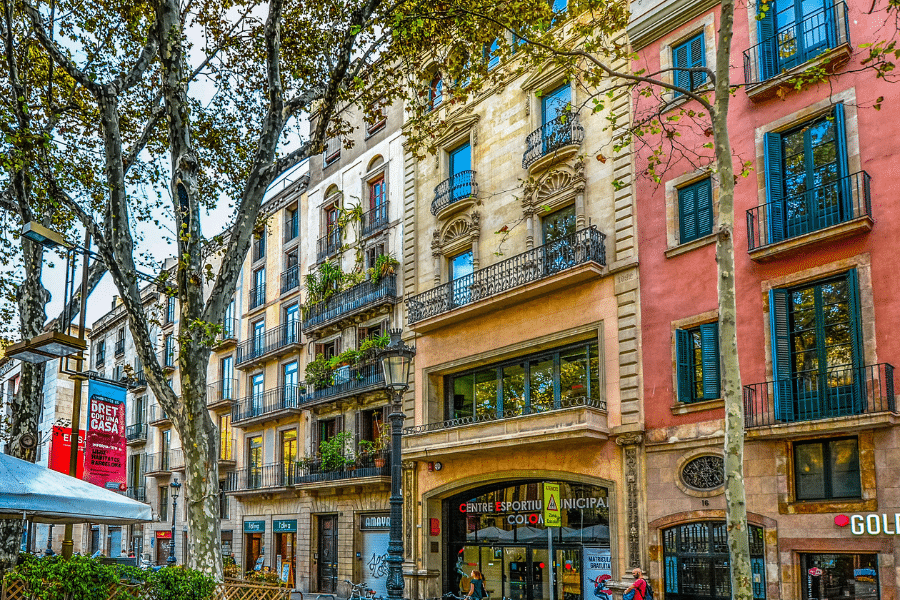
Family-friendly neighborhoods include Sarrià-Sant Gervasi, known for its green spaces and excellent schools; Pedralbes, an upscale area with spacious homes and international schools; and Gràcia, offering a village-like atmosphere with numerous plazas and family-oriented amenities. These areas typically feature a mix of modernist buildings and contemporary apartments, often with family-friendly features like communal gardens or pools.
Transportation and Walkability in Barcelona
Barcelona’s public transportation system is comprehensive and user-friendly. The metro, with its 8 lines, covers most of the city, while an extensive bus network fills in the gaps. The TMB app is invaluable for navigating the city, offering real-time updates and route planning.
Key metro lines like L3 (green line) connect major attractions from Plaça d’Espanya to Park Güell, while the L5 (blue line) links the city center with upper Barcelona. The tourist-friendly Bus Turístic offers hop-on-hop-off services to major sights.
Barcelona-El Prat Airport, located about 30 minutes from the city center, offers numerous international connections. High-speed AVE trains connect Barcelona with Madrid (2.5 hours), Valencia (3 hours), and Seville (5.5 hours).
The city center is highly walkable, with many attractions within a 20-minute walk. The expanding network of bike lanes and the Bicing bike-sharing system provide eco-friendly alternatives for short trips.
Healthcare in Barcelona
Barcelona is home to several world-class healthcare facilities. Hospital Sant Joan de Déu, located in Esplugues de Llobregat, is a leading pediatric center known for its cutting-edge treatments and research. Hospital Clínic, in the Eixample district, is a renowned public hospital with a strong reputation in various specialties, including obstetrics and pediatrics.
For private healthcare, Hospital Quirónsalud Barcelona in the Les Corts district offers a wide range of specialties and is popular among expatriates for its multilingual staff. The Dexeus University Hospital in Sarrià-Sant Gervasi is particularly noted for its maternity and reproductive health services.
3. Alicante
Family life in Alicante
Alicante offers a perfect blend of coastal living and urban amenities, making it an attractive destination for families. The city’s smaller size compared to Madrid or Barcelona creates a more intimate, community-oriented atmosphere. Alicante’s residents are known for their warm and welcoming nature, embracing both locals and newcomers alike.
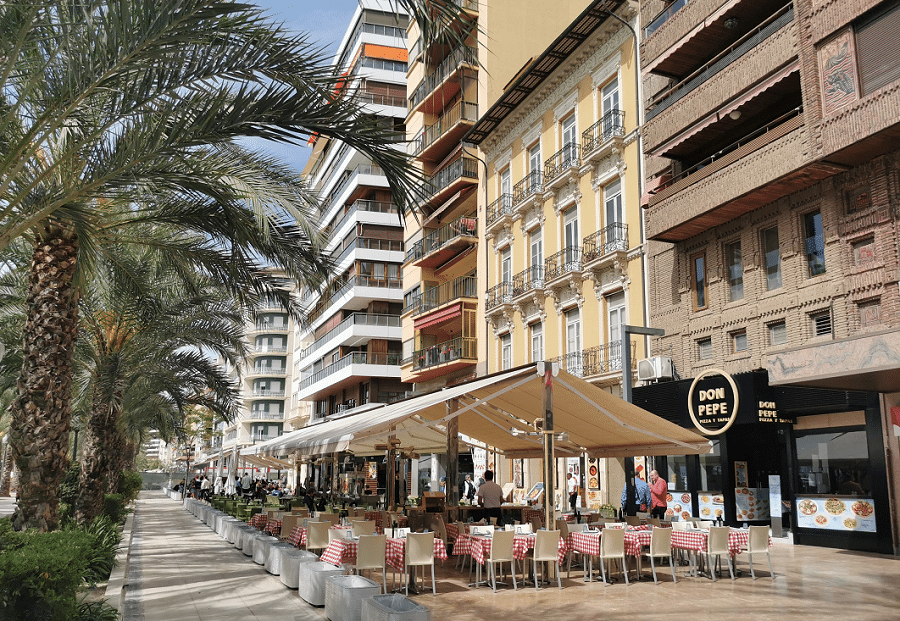
The Mediterranean climate encourages an outdoor lifestyle, with families often gathering in plazas or along the beachfront promenades. The city is generally safe, with a relaxed pace of life that appeals to many international families. While not as widely spoken as in larger cities, English is common in tourist areas and international communities, particularly in nearby expat-heavy towns like El Campello or San Juan.
Safety in Alicante
Alicante is considered a safe city for families, with lower crime rates compared to larger Spanish urban centers. Violent crime is rare, though petty theft can occur in crowded tourist areas, especially during the peak summer season. Family-friendly neighborhoods like Playa de San Juan, El Cabo, and Albufereta are known for their security and peaceful environments.
The city center, while generally safe, requires standard precautions against pickpocketing, particularly around the bustling Explanada de España or Mercado Central. Areas near the port and some parts of the old town may be less advisable late at night. The visible police presence, especially in tourist-heavy zones, contributes to the overall sense of security.
Schools in Alicante
Alicante and its surrounding areas offer several international schooling options. The Elian’s British School in nearby La Nucía provides a British curriculum from early years through A-levels. The European School Alicante, located in San Vicente del Raspeig, offers a multicultural education leading to the European Baccalaureate.
For those seeking an American-style education, the American School of Valencia, though further away in Puçol, is a popular choice among expat families in the region.
In the public sector, CEIP El Palmeral in the city center is known for its bilingual Spanish-English program and innovative teaching approaches. IES Jorge Juan, one of the oldest secondary schools in Alicante, offers a strong academic program and is centrally located.
CEIP Azorín in the Gran Vía area is praised for its inclusive environment and focus on arts and sports alongside academics.
Play and entertainment in Alicante
Alicante provides numerous entertainment options for families. The MARQ Archaeological Museum offers interactive exhibits that bring history to life for children and adults alike. The Alicante Planetarium, located in the Casa de las Ciencias, provides fascinating shows about space and astronomy. For animal lovers, the Mundomar marine animal park in nearby Benidorm offers dolphin shows and the chance to interact with sea lions.
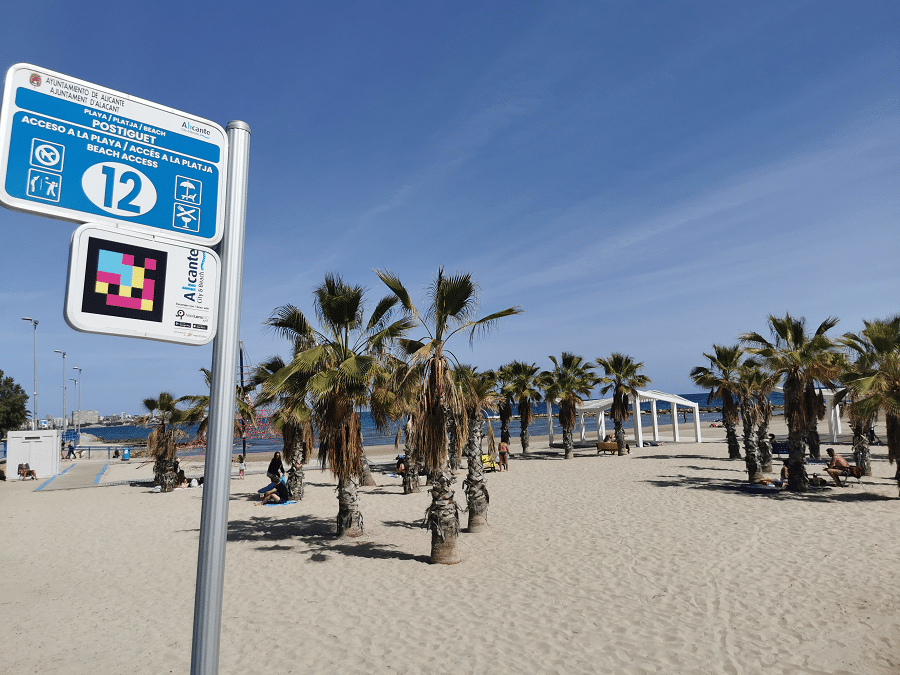
The city’s crown jewel for outdoor recreation is undoubtedly Playa del Postiguet, a beautiful urban beach with golden sand and calm waters perfect for families. El Palmeral Park, with its expansive green spaces, playgrounds, and even a mini-train, is a favorite among local families.
For a day trip, the Terra Mítica theme park in Benidorm, about 45 minutes north of Alicante, offers thrilling rides and shows based on ancient civilizations. Aqualandia, also in Benidorm, is one of Europe’s largest water parks and provides a refreshing escape during hot summer months.
Family-friendly housing in Alicante
Alicante’s housing market is very affordable for families. According to the Spain Rent Report 2024, the average rent in Alicante for a typical two-bedroom apartment costs around €900 per month. The cheap real estate makes Alicante an attractive option for families seeking a coastal lifestyle without the high costs associated with larger cities.
For those looking to buy real estate in Alicante, the average property price is approximately €2,100 per square meter. This translates to about €160,000 for a two-bedroom apartment or €420,000 for a house. In terms of home price per square foot, expect to pay about $215 per square foot, which equates to roughly $175,000 for a two-bedroom apartment or $430,000 for a house.
Family-friendly neighborhoods include Playa de San Juan, known for its beautiful beaches and modern apartments; El Cabo, offering a mix of traditional and contemporary housing close to the city center; and Albufereta, popular for its quieter atmosphere and proximity to both beach and city amenities.
These areas typically feature a blend of Mediterranean-style houses and modern apartment complexes, often with family-oriented amenities like communal pools and play areas.
Transportation and Walkability in Alicante
Alicante’s compact size makes it highly walkable, especially in the city center and along the coastline. The city also has an efficient public transportation system. The tram network, consisting of five lines, connects the city center with coastal towns and suburbs.
The Alicante Metropolitan TRAM app provides real-time updates and route planning for the tram system. Bus services, operated by TAM (Transporte Alicante Metropolitano), complement the tram network, reaching areas not covered by rail.
Key routes include Tram Line 1, which connects the city center with the popular beach area of Playa de San Juan, and Line 2, linking Alicante with the nearby town of El Campello. The C-6 bus route offers a scenic journey along the coast, ideal for day trips to nearby beaches.
Alicante-Elche Airport, located about 9 km (5.6 miles) southwest of the city, provides excellent connections to major European cities. High-speed AVE trains connect Alicante with Madrid (2.5 hours) and Valencia (1.5 hours).
The city center and beachfront areas are highly walkable, with most attractions within a 15-20 minute walk. Alicante has been investing in bike infrastructure, with an expanding network of cycle lanes and the introduction of a public bike-sharing system.
Healthcare in Alicante
Alicante boasts several high-quality healthcare facilities. Hospital General Universitario de Alicante, located in the north of the city, is the main public hospital, offering a wide range of specialties including pediatrics and maternity care. Hospital de San Juan, situated in the nearby town of San Juan, is another excellent public facility known for its modern equipment and research programs.
For private healthcare, Hospital Vithas Medimar Internacional in the city center is popular among expatriates for its multilingual staff and comprehensive services. The IMED Levante Hospital, located in Benidorm (about 45 minutes north of Alicante), is a modern private facility offering a wide range of specialties and is often chosen by families living in the coastal areas north of Alicante.
4. Murcia
Family life in Murcia
Murcia offers a more traditional Spanish lifestyle compared to larger coastal cities, with a strong emphasis on family values and community. The city’s manageable size creates a friendly, close-knit atmosphere where children are warmly welcomed.
Murcians are known for their hospitality, making it easier for international families to integrate. The city’s layout is relatively compact, promoting a pedestrian-friendly environment. While English is less commonly spoken than in more touristy areas, the growing international community has led to an increase in English speakers, particularly in educational and healthcare settings.
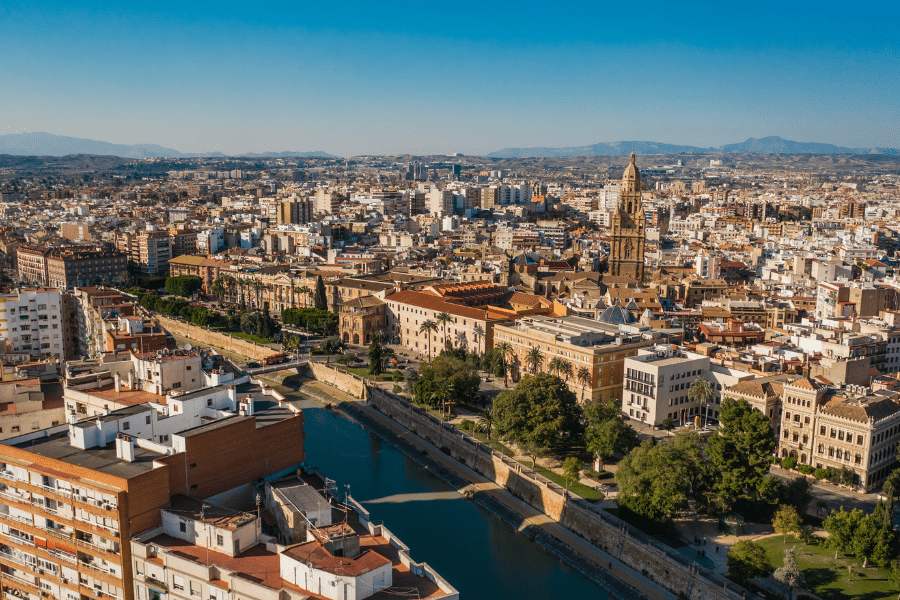
Safety in Murcia
Murcia is generally considered a safe city with lower crime rates compared to larger Spanish urban centers. Violent crime is rare, and most safety concerns relate to petty theft, particularly in crowded areas or during local festivals. Family-friendly neighborhoods like La Flota, Juan Carlos I, and San Antón are known for their security and community feel. The city center is generally safe, but standard precautions against pickpocketing are advised, especially in busy areas like Plaza de las Flores or around the Cathedral. The visible police presence in main squares and commercial areas contributes to the overall sense of security.
Schools in Murcia
While Murcia has fewer international schools compared to larger cities, it still offers some quality options. The King’s College Murcia, located in the nearby town of La Torre Golf Resort, provides a British curriculum from early years through A-levels. The Colegio Público Bilingüe Infante Don Juan Manuel in the city center offers a bilingual Spanish-English program within the public school system.
In the public sector, IES Alfonso X El Sabio is one of the most prestigious secondary schools in the region, known for its strong academic programs and central location. CEIP Nuestra Señora de Belén, in the San Antón neighborhood, is highly regarded for its inclusive approach and focus on arts and sports alongside academics.
Play and entertainment in Murcia
Murcia offers a variety of family-friendly attractions. The Museo de la Ciencia y el Agua (Science and Water Museum) provides interactive exhibits that make learning fun for children. The Terra Natura Murcia, a combined zoo and water park on the outskirts of the city, offers a full day of entertainment with animal exhibits and water attractions.
For outdoor recreation, the Parque Regional de Carrascoy y El Valle, just south of the city, provides numerous hiking trails and picnic areas. The Rio Segura, which runs through the city, has a beautiful riverside park with playgrounds and bike paths.
While Murcia itself is inland, the beaches of the Costa Cálida are just a 45-minute drive away, with the Mar Menor lagoon offering calm, shallow waters perfect for families with young children.
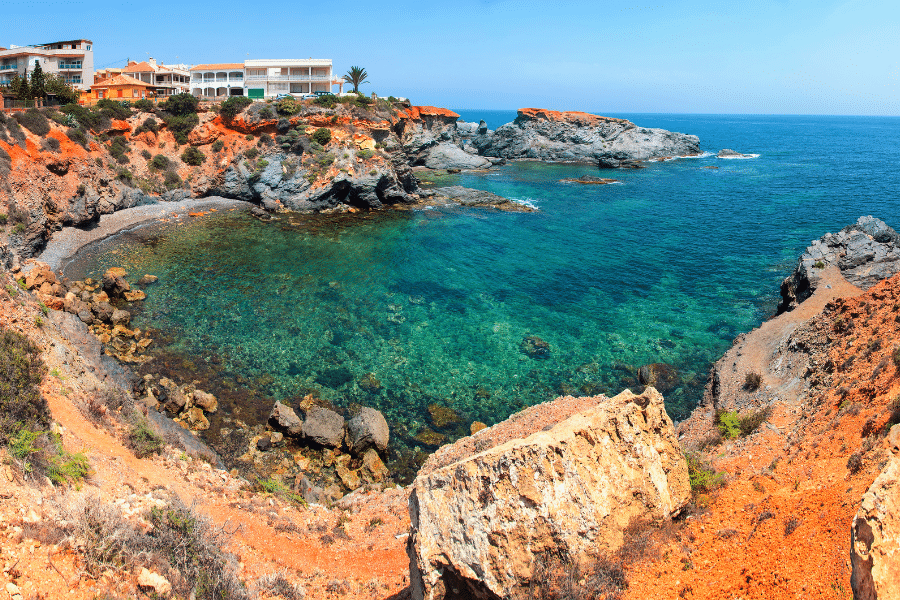
Family-friendly housing in Murcia
Murcia’s housing market is known for its affordability compared to many other Spanish cities. According to My Dolce Casa’s Spain Rent Report, a typical two-bedroom apartment costs around €700 per month. Low housing prices makes Murcia an attractive option for families seeking a balance between urban amenities and cost of living.
For those looking to buy, My Dolce Casa’s Murcia Region Real Estate Report shows an average home price at approximately €1,300 per square meter. This translates to about €97,000 for a two-bedroom apartment or €260,000 for a house. In terms of price per square foot, expect to pay only about $135 per square foot, which equates to just over $100,000 for a two-bedroom apartment or $270,000 for a 2,000-square-foot house, on average.
Family-friendly neighborhoods include La Flota, known for its modern apartments and proximity to schools; Juan Carlos I, offering a mix of housing types and good amenities; and San Antón, popular for its traditional charm and community atmosphere. These areas typically feature a mix of traditional Spanish-style houses and newer apartment complexes, often with family-oriented features like parks and playgrounds nearby.
Transportation and Walkability in Murcia
Murcia’s compact city center is highly walkable, with most attractions within easy reach on foot. The city has been investing in its public transportation system, with buses being the primary mode of public transit. The bus network, operated by Latbus, covers the city and surrounding areas effectively.
Key bus routes include the 39, which connects the city center with the University of Murcia, and the 1, which runs through the main commercial areas. The Murcia Public Transport app provides real-time updates and route planning for the bus system.
Murcia-San Javier Airport, located about 45 minutes southeast of the city near the Mar Menor, serves mainly domestic and some international flights. For more international connections, Alicante-Elche Airport is about 1 hour away by car. High-speed AVE trains connect Murcia with Madrid (3.5 hours) and Alicante (1 hour).
The city has been expanding its network of bike lanes, and a public bike-sharing system is available, making cycling an increasingly popular option for short trips.
Healthcare in Murcia
Murcia provides good healthcare options for families. The Hospital Clínico Universitario Virgen de la Arrixaca, located in El Palmar on the outskirts of Murcia, is the largest hospital in the region and a referral center for pediatrics and maternity care. Hospital General Universitario Reina Sofía, situated in the north of the city, is another major public hospital offering a wide range of specialties.
For private healthcare, Hospital Quirónsalud Murcia in the city center is popular among expatriates for its modern facilities and multilingual staff. The Hospital Mesa del Castillo, also centrally located, is another well-regarded private option known for its personalized care and range of specialties.
5. Marbella (Costa del Sol)
Family life in Marbella
Marbella offers a unique blend of luxurious coastal living and family-friendly amenities. The city’s international character, shaped by decades of tourism and expatriate communities, creates a welcoming environment for families from diverse backgrounds. Marbella’s residents, both local and international, generally maintain an open and friendly attitude.
The Mediterranean climate encourages an outdoor lifestyle, with families often gathering on the beaches or in the numerous parks. The city is considered safe, with a relaxed pace of life that appeals to many. English is widely spoken, particularly in tourist areas and international schools, making it easier for non-Spanish speaking families to settle in.
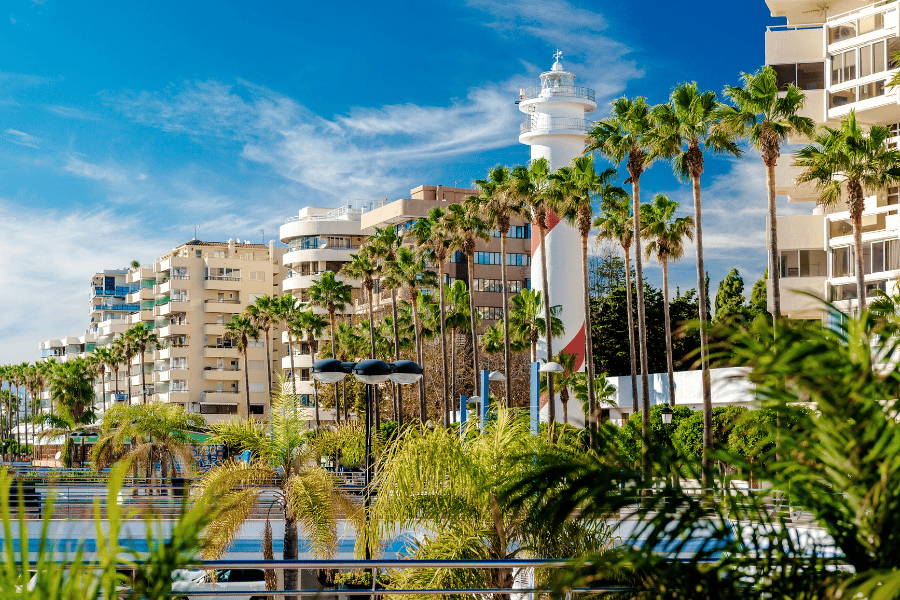
Safety in Marbella
Marbella is generally regarded as a safe city, particularly in its residential areas. However, as a popular tourist destination, it can experience higher rates of petty crime during peak seasons. Violent crime is rare, but precautions against theft and pickpocketing are advised in crowded tourist areas.
Family-friendly neighborhoods like Nueva Andalucía, San Pedro de Alcántara, and Elviria are known for their security and peaceful environments. The Golden Mile and Puerto Banús, while glamorous, require more vigilance due to their popularity with tourists. The visible police presence, especially in high-traffic areas, contributes to the overall sense of security.
Schools in Marbella
Marbella and its surrounding areas offer a wide range of international schooling options. The Aloha College in Nueva Andalucía provides an international education following the British curriculum and International Baccalaureate program. The English International College in Elviria offers a British curriculum from early years through A-levels. For those seeking an American-style education, the American College in Spain, located in nearby San Pedro de Alcántara, is a popular choice.
In the public sector, IES Guadalpín in the city center is known for its bilingual Spanish-English program and strong academic reputation. CEIP Juan Ramón Jiménez in San Pedro de Alcántara is highly regarded for its innovative teaching methods and inclusive environment.
Play and entertainment in Marbella
Marbella offers numerous family-friendly attractions. The Bioparc Fuengirola, located about 30 minutes east of Marbella, is a modern zoo focused on conservation and education. The Selwo Marina in nearby Benalmádena offers dolphin shows and the opportunity to learn about marine life.
The city’s crown jewels are its beautiful beaches, with Playa de la Fontanilla and Playa del Cable being particularly popular among families due to their calm waters and amenities. For green spaces, the Parque de la Constitución in the city center offers playgrounds, a small outdoor theater, and lush gardens. Aventura Amazonia, an adventure park in nearby Elviria, provides treetop obstacle courses suitable for various ages.
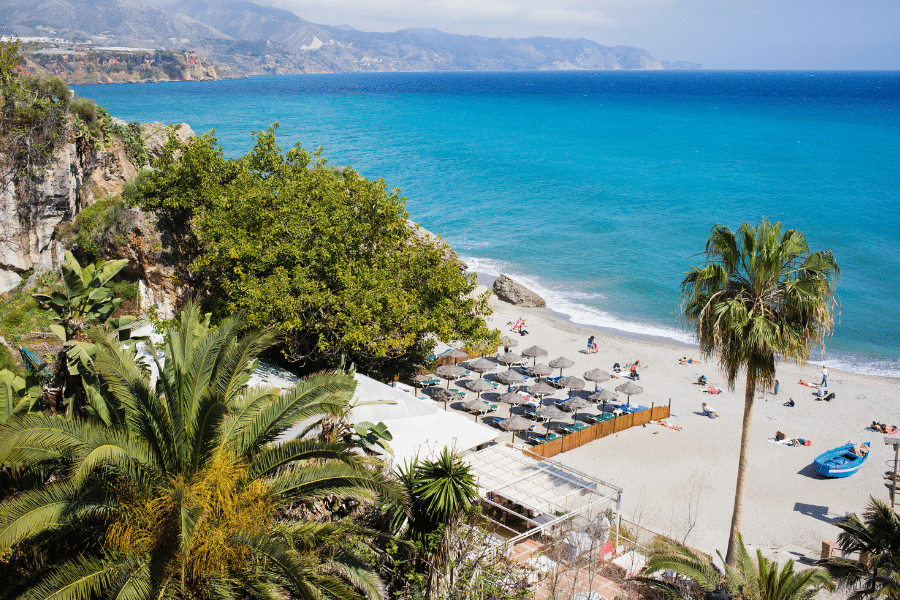
For water-based fun, the Aqualand Torremolinos water park, about 45 minutes east of Marbella, offers a range of slides and pools for all ages. The Tivoli World amusement park in Benalmádena, also about 45 minutes away, provides rides and shows for a full day of family entertainment.
Family-friendly housing in Marbella
Marbella’s housing market caters to a range of budgets, with a notable presence in the luxury sector. Renting is more affordable than buying a home in Marbella. The average rent in Marbella is €1,400 for a two-bedroom apartment, higher than the national average. This pricing reflects Marbella’s status as a premium coastal destination.
For those looking to buy, My Dolce Casa’s Andalucia Real Estate Report indicates that Marbella’s average property price is approximately €4,800 per square meter. This translates to about €360,000 for a two-bedroom apartment or €960,000 for a 200-sqm house. In terms of price per square foot, expect to pay about $490 per square foot, which equates to roughly $400,000 for a two-bedroom apartment or $980,000 for a house.
Family-friendly neighborhoods in Marbella include Nueva Andalucía, known for its golf courses and spacious villas; San Pedro de Alcántara, offering a mix of traditional Spanish charm and modern amenities; and Elviria, popular for its beautiful beaches and proximity to international schools.
These areas typically feature a mix of luxury villas, modern apartments, and traditional Spanish-style homes, often with family-oriented amenities like communal pools and gardens.
Transportation and Walkability in Marbella
Marbella’s layout makes it relatively easy to navigate, with many areas being walkable, especially along the beachfront promenade. The public transportation system, while not as extensive as in larger cities, is efficient for getting around. Buses, operated by Avanza Portillo, connect different parts of Marbella and neighboring towns.
Key bus routes include the L1, which runs along the coastal road connecting Marbella center with Puerto Banús, and the L4, which serves the inland areas of Nueva Andalucía. The Marbella Bus app provides real-time updates and route planning.
Málaga-Costa del Sol Airport, located about 45 minutes east of Marbella, offers extensive international connections. High-speed AVE trains from Málaga connect to major Spanish cities, with Málaga to Madrid taking about 2.5 hours.
While Marbella itself is quite walkable, especially in the Old Town and along the beach areas, having a car can be beneficial for exploring the wider Costa del Sol region. Taxi services and ride-sharing apps are readily available for those preferring not to drive.
Healthcare in Marbella
Marbella offers high-quality healthcare options. The Hospital Costa del Sol, located between Marbella and Fuengirola, is the main public hospital serving the area, known for its modern facilities and wide range of specialties including pediatrics and maternity care.
For private healthcare, Hospital Quirónsalud Marbella in the Golden Mile area is popular among expatriates and visitors for its multilingual staff and comprehensive services. The HC Marbella International Hospital, also centrally located, is another well-regarded private facility known for its oncology department and personalized care.

